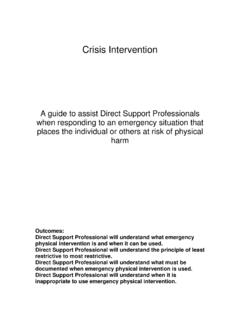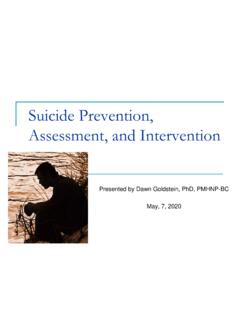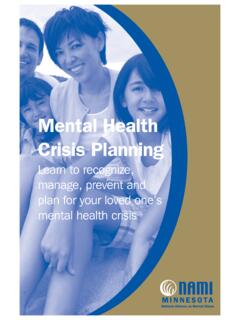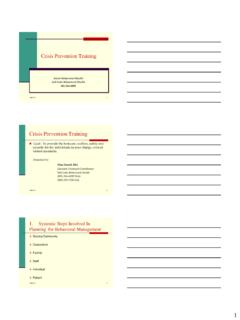Transcription of NONVIOLENT CRISIS INTERVENTION
1 NONVIOLENT CRISIS . INTERVENTION . Preventive INTERVENTION NONVIOLENT Physical CRISIS INTERVENTION Postvention Restraint use Any decision taken by staff to physically restrain a student should be exercised only in those circumstances where there is a real and immediate threat of injury to a person or serious damage to property and there is no other practical way of preventing the When can restraints be likely injury or damage.. used by teachers? DET Legal Issues Bulletin skip 1. Risk management Risk Management and Functional Assessment Under the Occupational Health and Safety Act 2000 . an employer must provide all available information necessary to enable relevant employees to fulfil their responsibilities with respect to: identifying hazards assessing risks arising from those hazards ".
2 Eliminating or controlling those risks monitoring and reviewing the risk control measures providing information to others FBA. Worksheet Purpose of NCI. The Purpose of NONVIOLENT CRISIS INTERVENTION To provide the .. WELFARE. CARE supporting emotional & physical well-being showing compassion & empathy SECURITY. SAFETY ensuring harmony not harm preventing danger, risk & injury .. for all those who are involved in a CRISIS situation CRISIS development model 1. 1. U nit The CRISIS Development Model CRISIS development/behaviour levels Staff attitudes/Approaches 1. Anxiety Supportive 2. Defensive An empathic, non- 3. Acting out approach judgemental person attempting to alleviate A noticeable increase or change anxiety in behaviour eg pacing, finger 4.
3 Tension reduction tapping, staring, wringing hands 2. CDM - Defensive The CRISIS Development Model CRISIS development/behaviour levels Staff attitudes/Approaches 1. Anxiety Supportive 2. Defensive Directive 3. An approach in which a staff The beginning stage of loss of 4. member takes control of a rationality. At this stage, an potentially escalating individual often becomes situation by setting limits belligerent & challenges authority CDM - Acting out The CRISIS Development Model CRISIS development/behaviour levels Staff attitudes/Approaches 1. Anxiety Supportive 2. Defensive Directive 3. Acting out person NONVIOLENT physical CRISIS INTERVENTION Safe, non-harmful control and 4.
4 Restraint positions to safely control an individual until he can regain The total loss of control control of his behaviour. These which results in a physical techniques should be utilised as a acting-out episode last resort, when an individual presents a danger to self or others. CDM - Therapport The CRISIS Development tegr rie nc Model ated exp e in e CRISIS development/behaviour levels Staff attitudes/Approaches 1. An Anxiety approach used to re- Supportive establish communication with an A decrease in physical and individual who is experiencing emotional energy that occurs 2. Tension Defensive Reduction. Builds Directive after a person has acted out, relationships with individual after characterised by the 3.
5 A CRISIS . Acting out person NONVIOLENT regaining ofphysical rationality CRISIS INTERVENTION 4. Tension reduction Therapeutic rapport Reasons for using the CRISIS development Model helps us to intervene early and appropriately helps us to avoid overreacting or under-reacting helps us to avert a CRISIS 3. The CRISIS model THE CRISIS CYCLE. Integrated experience anx iety External control Staff actions ion u ct INTERVENTION ownership red ion de s fe ten nsi v e Internal control Client actions ac tin g out preventive corrective restorative Prepare - Hudson landing Rehearse, PREPARE,Review, Respond PLAN, PERFORM. Non-verbal behaviour 2.
6 Un it NON-VERBAL BEHAVIOUR. 1. Proxemics - Personal space Generally 1/2 to 1 metre 2. Kinesics Includes- personal Body language items such as backpacks, purse, mobile phone, aids Affected by other factors such as gender, size, 3. Reasons culturalfor using the background, CPI Supportive familiarity .. Stance 2. Kinesics - Body language 3. Reasons for using the CPI Supportive Stance 4. Non-verbal - Proxemics 2. U nit NON-VERBAL BEHAVIOUR. 1. Proxemics - Personal space 2. Kinesics - Body language 3. Non-verbal Reasons message for using transmitted the by the motion CPI Supportive and Stance posture of the body Includes include facial expressions, gestures, posture and movements Can serve to escalate or de-escalate a given situation.
7 A challenging or confrontational body position used when approaching an individual may increase anxiety and make defusing the situation more difficult. 3. Reasons for using the CPI Supportive Stance Supportive stance 2. U nit NON-VERBAL BEHAVIOUR. 1. Proxemics - Personal space 2. Kinesics - Body language 3. Reasons for using the CPI Supportive Stance Communicates respect by honouring personal space Is non-threatening/non- challenging At least one leg length away Contributes to staff s personal Slightly off to the side safety if attacked/offers an escape Positioned in a L shape route Staff it 3 PARAVERBAL COMMUNICATION.
8 Un Paraverbal How you say what you say. Components Tone - avoid inflections of impatience, frustration, condescension, inattention .. Volume - keep the volume appropriate for the distance and the situation Cadence - use an even rhythm and rate to deliver the message Staff 5. Paraverbal example 3. U nit PARAVERBAL COMMUNICATION. How you say what you say. Try this example: I didn t tell staff you stole the money Staff it 4 VERBAL COMMUNICATION. Un Verbal Escalation kite The CPI Verbal Escalation Continuum 3. Release 4. Intimidation defensive 2. Refusal 5. Tension reduction 1. Questioning it 4 VERBAL COMMUNICATION. Un Questioning The CPI Verbal Escalation Continuum Rational, valid 1.
9 Questioning questions seeking a rational response A. Information seeking B. Challenging Questioning authority, evasive, drawing others into What are we doing today? a power struggle interventions :What page are we on? What Wherethe dopoint of learning you want thistoday? me to sit crap? A. Answer the Whoquestion, Whereare youtogive doyou a rational tell me want me what to go? response to do? Since when do you know how to teach maths? B. Avoid, ignore Why the challenge, don t you try andredirect make meback leave?to the issue. Set limits if the individual persists 6. it 4 VERBAL COMMUNICATION. Un Refusal - limits The CPI Verbal Escalation Continuum 2.
10 Refusal Non-compliance, slight loss of rationality Limits are better received interventions : when a positive choice and consequence are stated first. Set limits more Effective limits are: simple and clear Allow some take up time reasonable for the student to decide enforceable it 4 VERBAL COMMUNICATION. Un Refusal - Ginott The CPI Verbal Escalation Continuum 2. Refusal Non-compliance, slight loss of rationality Some interesting ideas from Haim Ginott Haim Ginott argued that you can quite easily give a child compassionate emotional support and firm boundaries at the same time. He believed that you could set firm limits on their behaviour, but still respect a child's feelings.








